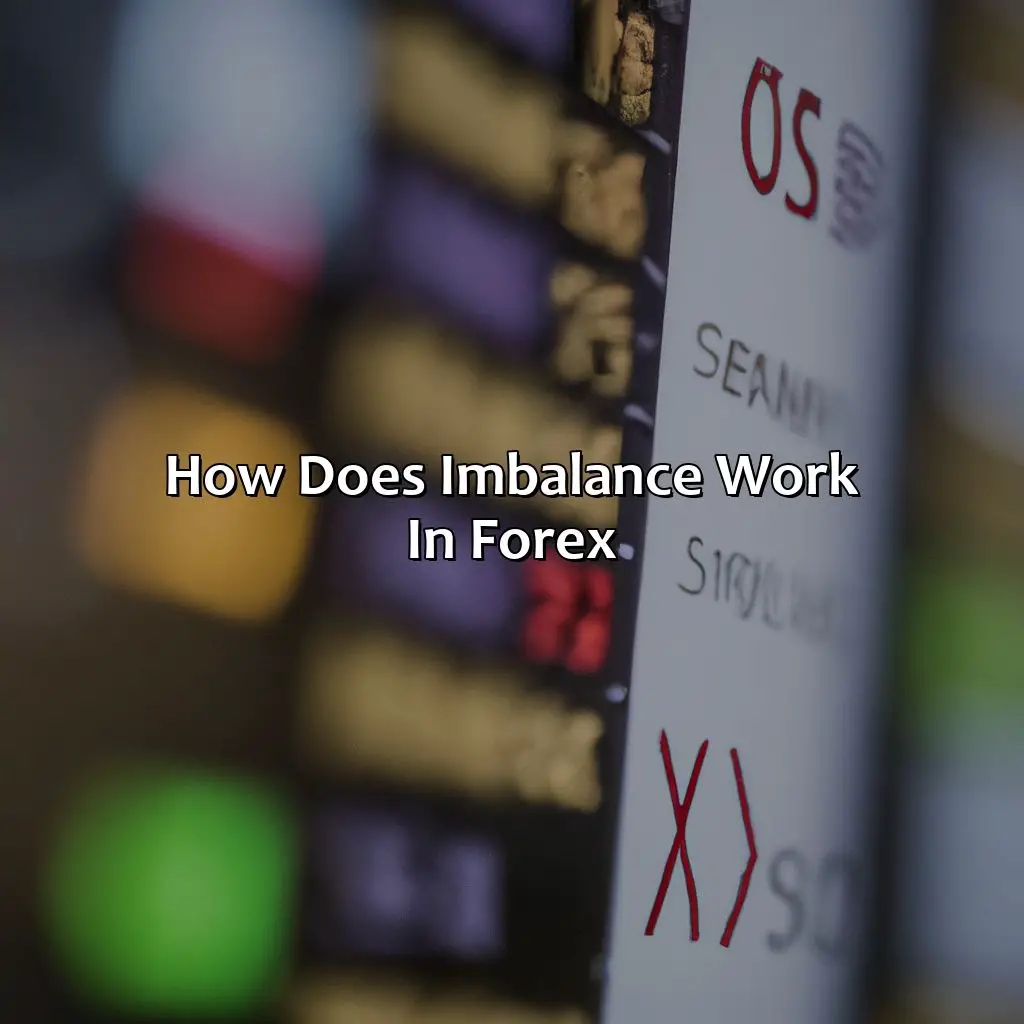
Key Takeaways:
- Imbalance in forex refers to the situation where the supply and demand for a currency are uneven, causing fluctuations in the exchange rate. It can be caused by various factors such as trading strategy, market orders, limit orders, stop orders, time-weighted average price orders, and high-frequency trading.
- Imbalance in forex can result in significant price changes, spread widening, slippage, order rejection, and order filling delay. It is important to monitor imbalance using order book analysis, volume analysis, price action analysis, and news and economic data analysis.
- Trading strategies such as scalping, news trading, stop hunting, order flow trading, and trend trading can be used to profit from imbalance in forex. However, traders must also be aware of the potential risks and losses associated with these strategies.
Definition of Imbalance in Forex
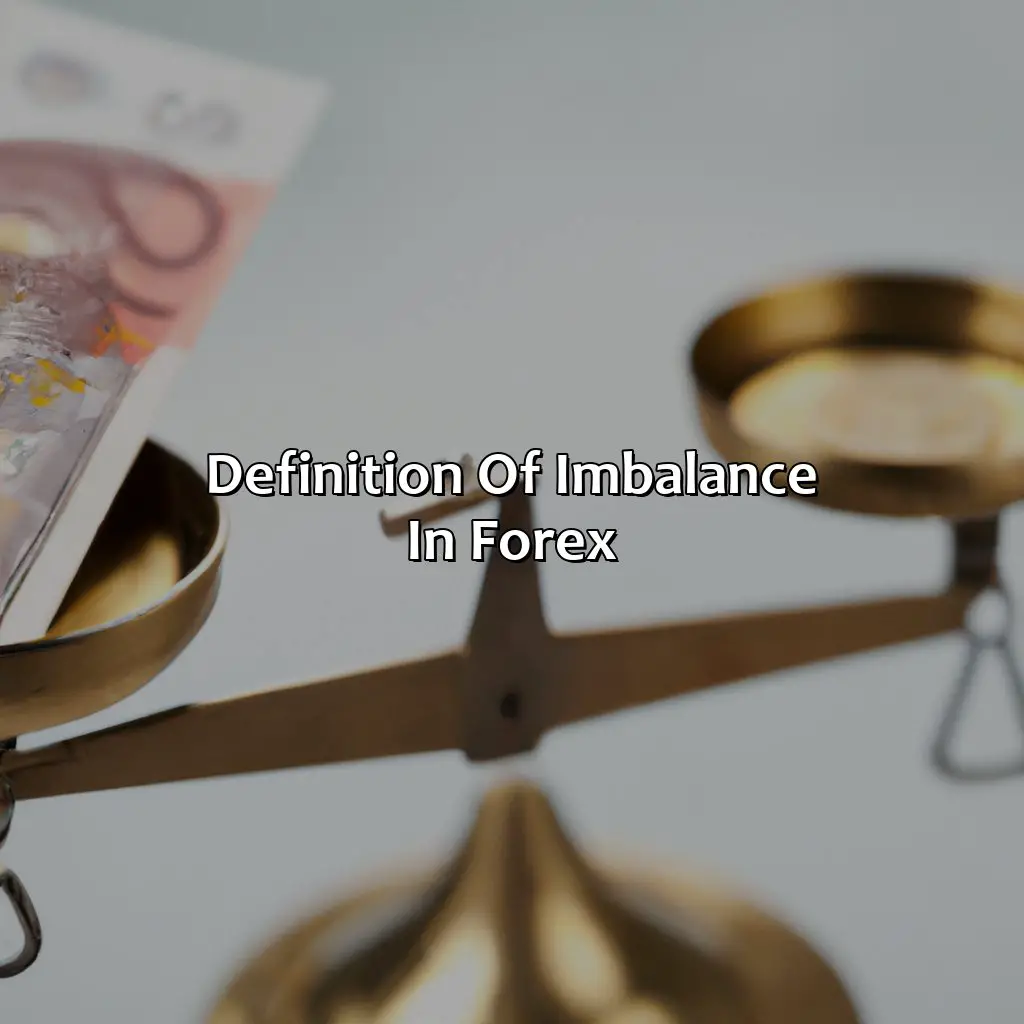
Photo Credits: forexbrokerreport.com by Charles Ramirez
The concept of imbalance in forex refers to the situation where the demand and supply of a particular currency are not equal. This leads to an imbalance in the market, affecting the price of the currency. Imbalance can be caused by various factors such as economic events, political situations, and investor sentiment.
When there is an excess demand for a currency, it typically leads to an appreciation in its value, whereas an excess supply leads to a depreciation. Imbalance is a crucial aspect of forex trading and helps traders gauge the market sentiment.
In forex, the balance of demand and supply of currency is essential to determine its market value. Imbalance, therefore, indicates a change in market sentiment resulting from a shift in the supply and demand balance. For example, a country with a high supply of currency may reduce its value due to the lack of demand from investors. Similarly, if a country’s economic prospects are viewed favorably, the demand for its currency may rise irrespective of an influx of supply. Therefore, forex traders use a variety of tools and analysis to detect imbalance and adjust their trading strategies accordingly.
Imbalance can be further classified as temporary or permanent. Temporary imbalance can be caused by sudden news releases that can significantly affect the supply and demand of currency. This is often observed when the market reacts to news like rate changes, economic or political events. Permanent imbalance, on the other hand, usually arises due to longer-term structural changes like changes in policies, regulations, and geopolitical shifts, which can impact the market for an extended period.
Understanding the concept of imbalance is a critical aspect of forex trading. Traders must keep a continual eye on the market to detect any significant changes or shifts in sentiments that may cause imbalance. Failure to do so can lead to missed opportunities or even losses. Stay ahead of the competition by keeping up-to-date with the latest trends and analysis to make informed trading choices.
Causes of Imbalance in Forex
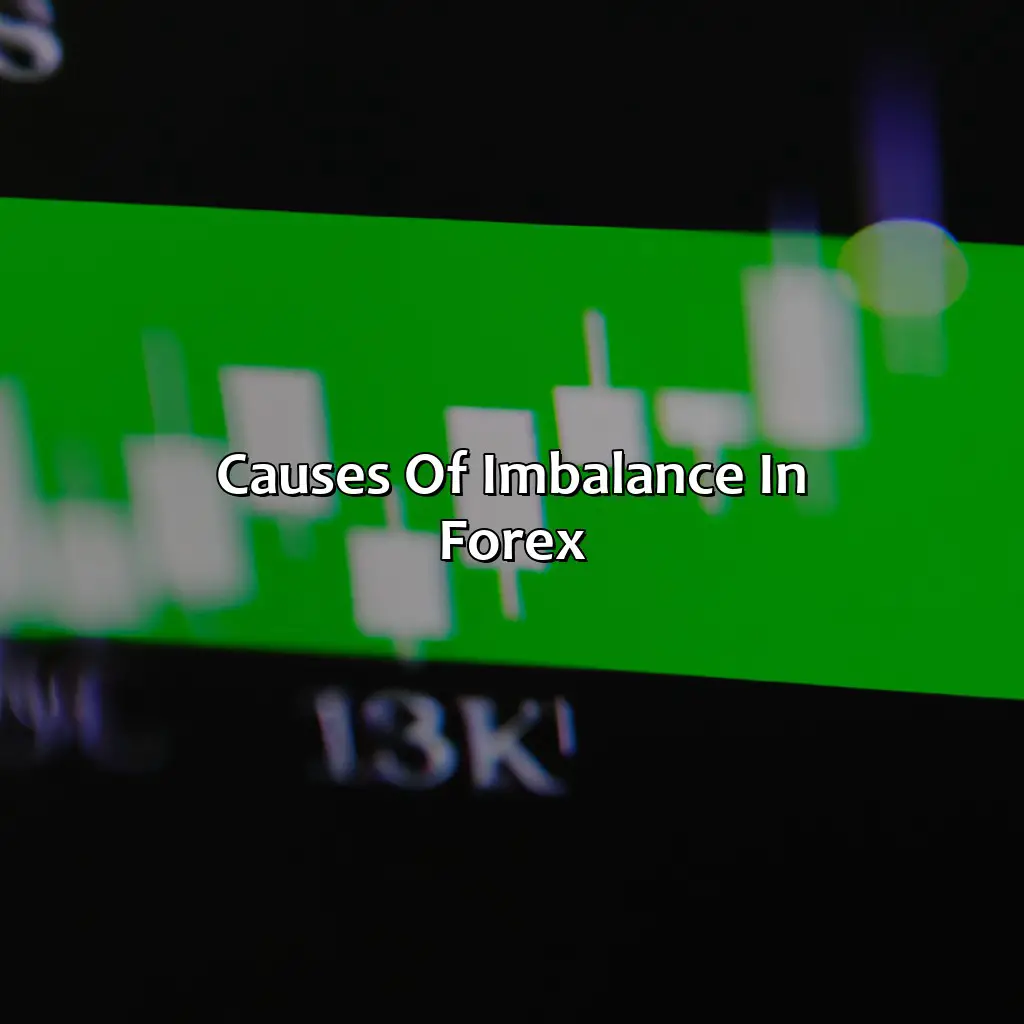
Photo Credits: forexbrokerreport.com by Adam Hill
For a grasp on why Forex trading can be imbalanced, use diverse trading strategies. Five sub-sections must be contemplated:
- Market orders
- Limit orders
- Stop orders
- Time-weighted average price orders
- High-frequency trading
Each sub-section provides a separate solution for managing the risk in currency exchange markets.
Market Orders
When traders want to buy or sell a currency pair at the current market price, they use a type of order known as market orders. Market orders execute quickly and provide immediate entry into the market. These orders are essential for traders who prioritize entry speed over precise pricing. In trading, Market Orders are highly effective because they provide immediacy in opening a position.
Market orders carry an inherent risk of slippage, meaning that the execution price could be different from the desired one due to rapid market fluctuations. Therefore, it is crucial to have an understanding of the current market conditions before placing this type of order to prevent any potential losses.
One recommendation when using market orders would be to enter slowly, starting with small sizes, instead of going all-in at once. Traders can also benefit from setting stop-loss orders when entering the trade with larger sizes to protect themselves from adverse price movements if they occur unexpectedly.
Overall, when used correctly, market orders can be extremely useful for traders looking to enter markets quickly and efficiently. However, caution should be taken while using them as it carries potential risks.
Limit orders are like that friend who promises to show up at a party but never does – they limit your potential losses, but can also limit your profits.
Limit Orders
When we talk about the trading of financial instruments, limit orders come into play. These are a type of order in which traders set a specific price at which they want to buy or sell an instrument, with the condition that the trade will only be executed if the market reaches that specific price.
Limit orders are used by traders looking to enter or exit positions at a specific price. They help manage risk and can be used for both buying and selling. They allow traders to buy below the current market price and sell above it.
It is essential to note that limit orders may not always get filled if the market does not reach their specified price. Additionally, limit orders can also lead to imbalances as there could be many buyers or sellers waiting for their orders to execute at their desired prices.
Pro Tip: Trading with Limit Orders requires careful consideration of the current market conditions and how they may affect your trade’s execution. It’s crucial to determine your entry and exit points before placing a Limit order and keep monitoring the market movements to avoid being trapped in an imbalance situation.
Stop orders can stop your losses or stop your profits, depending on the market’s mood.
Stop Orders
When traders use stop orders in forex trading, they are instructing their broker to execute a trade at a specified price point. This is with the understanding that if the currency pair reaches this price point, it is likely to continue moving in the same direction and they would like to enter or exit a position accordingly.
Stop orders can be either buy stop or sell stop orders. Buy stops are placed above the current market price as traders anticipate that prices may continue to rise. When prices surpass the indicated threshold, a long position is opened. Conversely, sell stops are set below the current market price because traders expect prices to decrease further. Once reached, sell stops open short positions.
Traders often use stop orders for risk management purposes as they limit losses by closing losing trades when prices move against them.
Pro Tip: Always keep an eye on your stop-loss order placements, and ensure the placement is logical depending on price movement trends and volatility in currency pairs.
Time-weighted average price orders: Because sometimes you need to take an average to make sense of the chaos that is trading.
Time-Weighted Average Price Orders
Time-Weighted Average Trading (TWAP) is a type of algorithmic trading that allows investors to buy or sell in large volumes without affecting the market prices significantly. The TWAP orders are designed to execute the transactions over a predefined period and average the prices accordingly.
| Description | |
| Order Type | Algorithmic |
| Execution Time Frame | Predefined period defined by traders or investors |
| Market Impact | Minimal/ Negligible |
TWAP orders are preferred by institutional investors who deal with massive transactions but do not want their trades to move the markets instantly. These orders break down larger transactions into smaller chunks and execute them evenly over a particular timeframe, averting the possibility of immediate price swings.
Pro Tip: Implementing sophisticated algorithms like TWAP can help traders minimize market impact, reduce slippage, and increase order execution speed.
High-frequency trading: when your computer makes more money than you ever will.
High-Frequency Trading
High-Speed Trade – an Overview
High-speed trade is an electronic trading strategy that uses complex computer programs and algorithms to execute trades at high speeds and with high frequency. This form of trading is popular among traders due to its ability to generate profit by exploiting small price changes in the market.
The practice of High-frequency trading makes use of ultra-fast telecommunications networks to accelerate the process, enabling traders who employ this strategy to capitalize on market conditions within milliseconds. Such speedy response times provide participants with a significant edge over novice traders who tend to face lags when entering orders into the system.
It is necessary for High-speed Trade operators to have access to low-latency execution mechanisms like Direct Market Access (DMA) technologies, co-location facilities, and smart order-routing systems that facilitate speedy access to relevant price data.
An interesting aspect of High-Speed Trading strategies is their ability, in some cases, to also act as market-makers or liquidity providers.
As more exchanges open doors towards automated systems for trading securities, one can expect High-speed trade practices occupying a larger slice of the pie and being integrated into traditional strategies.
When imbalance strikes in forex, expect the currency exchange market to be like a rollercoaster ride with wild volatility and unpredictable fluctuations.
Effects of Imbalance in Forex
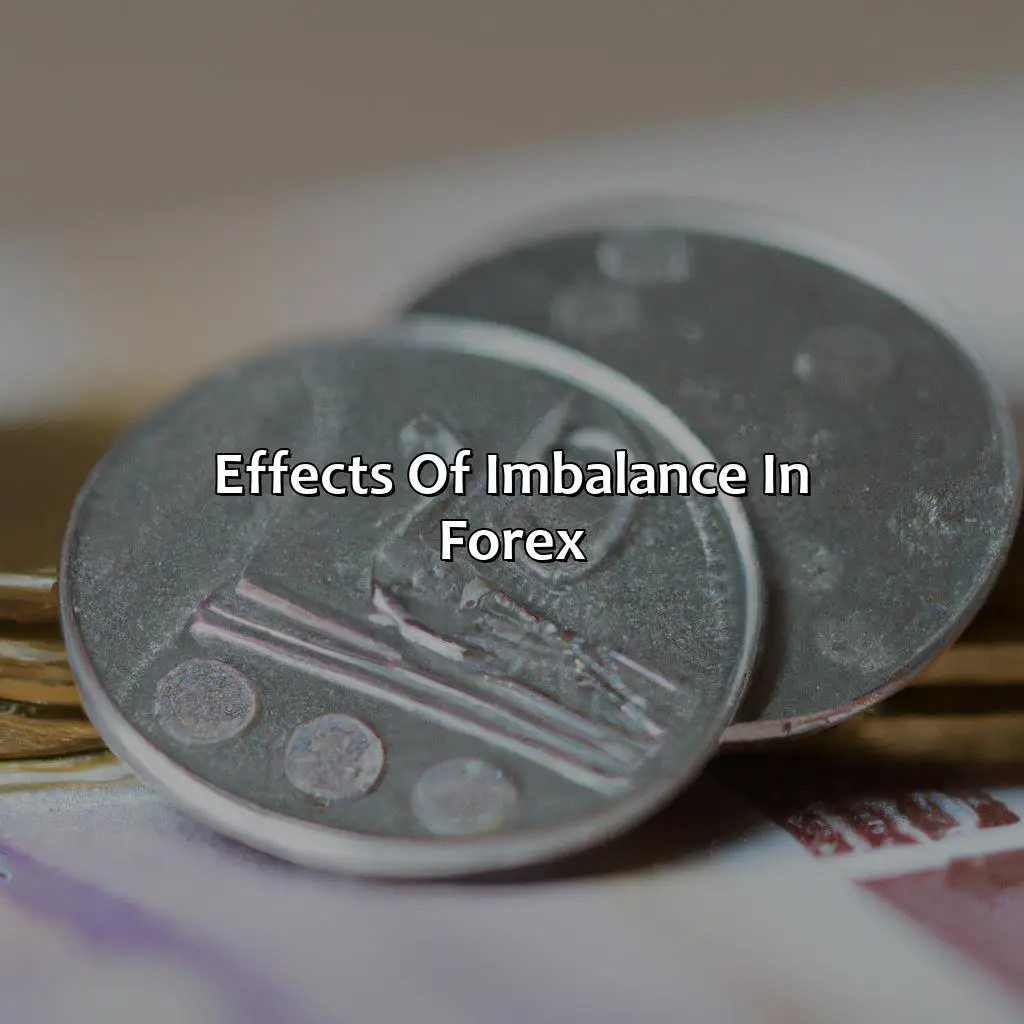
Photo Credits: forexbrokerreport.com by Bobby Rivera
Gaining an insight into how imbalance in forex affects us, requires understanding its solutions. To overcome the issues in the currency exchange market, it is essential to be familiar with the sub-sections. These are:
- Price changes causing volatility
- Spread widening and fluctuations
- Slippage and volatility
- Order rejection which brings risk
- Order filling delay which increases risk.
Price Changes
The market’s imbalance level can cause rapid or gradual changes in currency prices, leading to volatility and unpredictability for traders. The significant increase in seller orders or the lack of buyers can result in a sharp fall in prices, while an increase in buyer orders can lead to price hikes.
Such price changes can impact traders’ profits and trading strategies, making it crucial to keep track of market imbalances. Moreover, sudden volatility resulting from price changes can cause unexpected slippage and delays in order filling.
While monitoring price changes due to imbalance is essential for minimizing losses and maximizing returns, traders must also be cautious not to overreact and make hasty trading decisions based on short-term market trends. In fact, analyzing historical market data can provide valuable insights into how imbalances affect prices over time while helping identify potential opportunities for profit. For instance, tracking the long-term impact of an increase or decrease in trading volume due to imbalances on currency pairs could help traders identify suitable entry or exit points.
In summary, staying informed about changes in forex prices resulting from market imbalances requires close attention to order book analysis and volume as well as closely monitoring economic data releases. By staying vigilant and adopting sound risk management practices, traders can leverage imbalances to their advantage by implementing effective trading strategies designed around these fluctuations.
Spread widening in Forex is like a rollercoaster ride, full of unexpected fluctuations and stomach-churning drops.
Spread Widening
As the market becomes imbalanced, spread widening occurs. This is when the difference between bid and ask prices increases beyond the normal range. It is significant because it makes trading expensive as traders are required to pay this increased spread.
Moreover, this phenomenon of spread widening can be a result of fluctuations in supply and demand. These fluctuations can be caused by different market forces such as changes in interest rates, economic data releases and geopolitical events. As a result, the market makers may increase the size of their spreads to protect themselves from volatility.
One unique detail about spread widening is that it can create an environment where traders are hesitant to enter or exit positions due to high costs related to spreads. Hence, it can cause greater price movements than otherwise expected.
According to a research article published by UK’s Financial Conduct Authority (FCA) in 2018, “market makers have widened their spreads during periods of heightened market stress”. This study provides evidence that during these periods of turbulence, brokers had significantly higher average spreads for certain currency pairs compared to normal periods.
Slippage in forex is like trying to catch a falling knife – you might end up getting cut by volatility.
Slippage
When executing a trade, slippage refers to the difference between the expected price of an order and the actual executed price. Slippage can occur due to various factors such as market volatility, liquidity, and order size. In Forex, slippage is a common occurrence and can cause significant losses for traders.
Slippage occurs when there is a delay in fulfilling an order due to insufficient liquidity or market volatility. This delay may result in the execution of the order at a different price than intended. Moreover, it can also occur if orders are placed during peak trading hours when markets are highly volatile.
Traders should be aware of slippage and its impact on their trades. They can try to minimize slippage by placing limit orders instead of market orders, as limit orders guarantee execution at a specified price or better. Additionally, traders must manage their risk by maintaining stop-loss orders and keeping an eye on news and economic data that can impact volatility.
Pro Tip: To reduce slippage risks while trading Forex, consider using smaller trade sizes and avoiding placing trades during major market events or announcements.
Order rejection in Forex is like getting dumped by your crush, except it can cost you money and increase your risk.
Order Rejection
Traders place orders in the Forex market with the intention of buying or selling a currency pair at a specific price. However, due to an imbalance in the supply and demand, sometimes these orders get rejected by the market. This can result in missed trading opportunities and increased risk for traders.
Order rejection refers to the inability of a trader’s order to be executed at their desired price. This happens when there aren’t enough buyers or sellers willing to trade at that particular price level. This can also occur due to disruptions in the trading infrastructure, such as technical glitches or network issues.
It’s important for traders to be aware of the risks associated with order rejection and take steps to mitigate them. One way is by diversifying their trading portfolio and not relying too heavily on one particular currency pair or trading strategy. Additionally, they can use limit orders instead of market orders, which allows them more control over their entry and exit points.
A true story about order rejection involves a trader who placed a large market order during a highly volatile time in the market, only to have it rejected due to lack of liquidity at that moment. As a result, they suffered significant losses and learned an important lesson about managing risk and being cautious during extreme market conditions.
Order filling delays are a risky game of waiting that no trader wants to play in the fast-paced world of Forex.
Order Filling Delay
In the dynamic world of forex trading, delays in order filling can significantly impact profitability and expose traders to risk. Delayed order execution may occur due to various reasons such as network latency, insufficient liquidity, and volatile price movements. As a result, traders may miss out on favorable market conditions or even incur losses if the market turns against their intended position.
Order execution delays can lead to missed opportunities or losses for traders who are unable to act on time-sensitive market information. These delays can be caused by technology failure, incorrect trade parameters entered into the system, or high levels of trading activity that clog up the order book. To anticipate and manage this risk, traders must have a clear understanding of their broker’s capabilities for executing trades in various market conditions.
It is vital for traders to adopt risk-management strategies when dealing with order filling delay situations. Some ways to mitigate this risk include using stop-loss orders to limit downside exposure or implementing hedging strategies. By being proactive rather than reactive in response to potential trading issues, experienced traders can navigate these challenges more effectively.
To avoid missing out on profitable trading opportunities due to delayed order fills, it is important for traders to stay informed of current market conditions and remain vigilant about maintaining precise control over their orders. By keeping track of events that could impact currency markets – such as economic data releases or central bank policy meetings – traders can make informed decisions based on accurate information rather than speculation.
Keeping an eye on Forex imbalance is like being a detective in the currency exchange market, analyzing every clue from order book to volume, price action, news, and economic data.
How to Monitor Imbalance in Forex
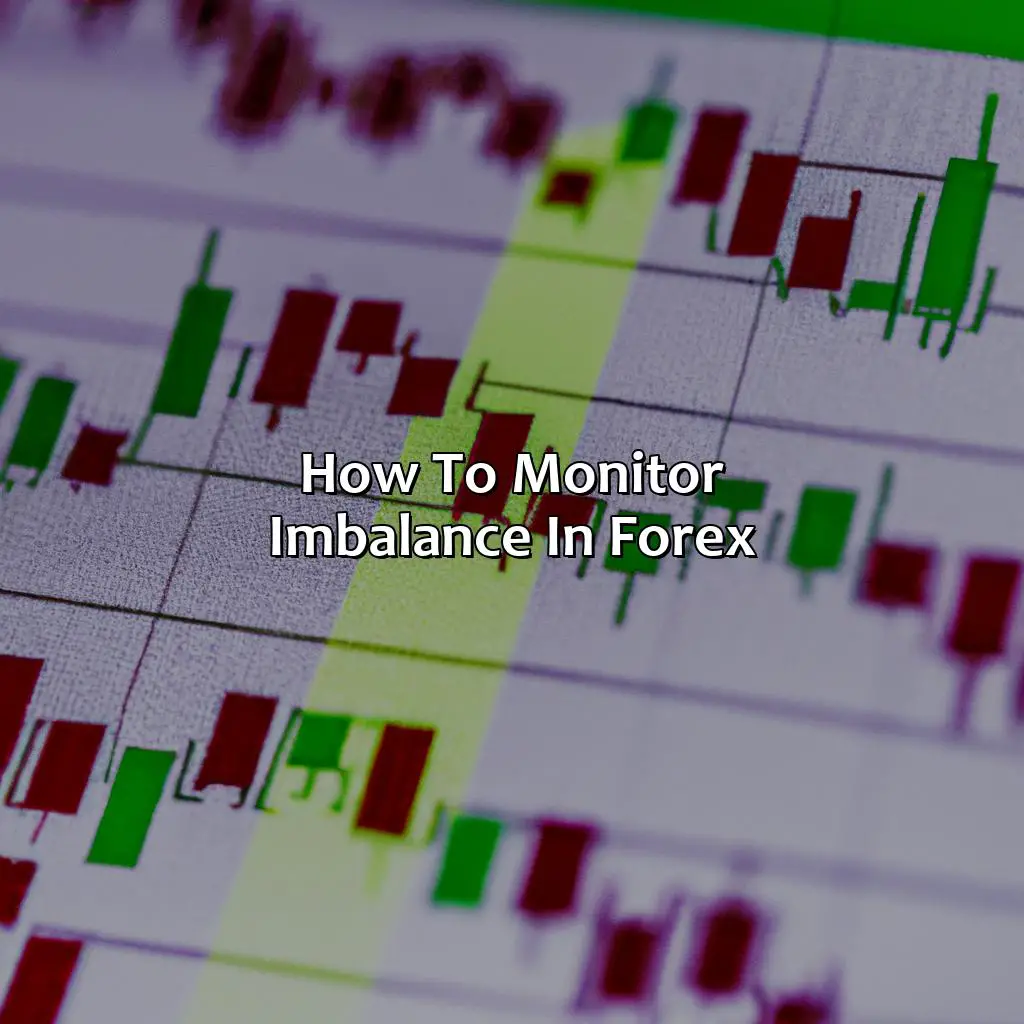
Photo Credits: forexbrokerreport.com by Philip Moore
Monitoring forex imbalances? Explore solutions! Look at order book analysis, volume analysis, price action, and news/economic data analysis. Each has key indicators – they give great insights on the currency exchange market. Use these different methods to gain a more complete understanding of the market – that way, it’s easier to make informed trading decisions.
Order Book Analysis
Analyzing the Order Book in Forex allows traders to gain valuable insights into the market’s supply and demand dynamics. The information obtained through these analyses helps traders make informed trading decisions by identifying potential price levels at which orders are more likely to be executed.
The table below displays some of the most commonly used indicators for analyzing the order book:
| Indicator | Definition |
|---|---|
| Bid/Ask Spread | The difference between the highest bid and the lowest ask prices. |
| Market Depth | The number of buy and sell orders at each price level within a certain range around the current market price. |
| Open Interest | The total number of outstanding contracts or positions held by market participants on a particular currency pair. |
| Time & Sales | Displays all completed transactions (time) along with their corresponding volume and price (sales). |
It is important to note that although different platforms may provide varying degrees of detail, traders must always approach order book analysis with a critical eye. This means understanding how to filter out noise and identify significant patterns that can lead to profitable trades.
To further deepen your understanding of supply and demand dynamics in Forex trading, consider learning more about Volume Analysis, Price Action Analysis, News Trading, and Economic Data Analysis.
Don’t miss out on opportunities to trade successfully by ignoring informative techniques such as order book analysis –implement them into your trading strategy today!
Analyzing volume in forex is like listening to the heartbeat of the market, providing crucial insights for profitable trades.
Volume Analysis
Analyzing the volume in forex trading is an important aspect of understanding the market and making informed decisions. By examining the trading activity of buyers and sellers, traders can identify trends and patterns that can help predict future price movements.
A table can be used to display volume analysis data with columns such as Date, Currency Pair, Volume (lots), and Average Volume for a specific time period. This allows traders to track changes in volume over time and identify any anomalies or trends in trading activity.
In addition to volume indicators like on balance volume (OBV) and chaikin money flow (CMF), traders can also use price-volume analysis by examining how changes in price affect trading volume. For example, if an increase in price is accompanied by high trading volume, this may signal increased buying pressure from investors.
Pro Tip: Use multiple indicators for robust analysis and consider using charting software for easy visualization of volume data. Analyzing price action is like deciphering a mystery novel, but instead of clues, we’re looking for hints in the charts and indicators.
Price Action Analysis
Analyzing price action in Forex involves studying the movement of prices on a chart without relying on indicators. This is done by observing support and resistance levels, candlestick patterns, and other technical analysis tools to predict market trends.
Price action analysis requires discipline and critical thinking to identify trading opportunities based on market conditions. Traders who use price action analysis can make informed decisions without being influenced by inaccurate or lagging indicators. In addition, this approach can help traders better understand how the market moves and react to changes in sentiment. Traders must be able to accurately interpret price action signals to identify profitable trade setups.
Price action analysis can be complemented with the use of other technical indicators for confirmation or validation purposes. The integration of these tools allows for a more comprehensive view of market movements. However, over-reliance on indicators can lead to false signals, which may result in losses.
Incorporating price action analysis into your trading strategy requires practice and experience. As traders become more proficient in identifying patterns, they will be able to improve their decision-making process and increase their chances of success. Don’t miss out on potentially lucrative trades by neglecting this analytical tool in your trading arsenal.
Whether you’re a bull or a bear, staying on top of news and economic data analysis is key to profiting in forex.
News and Economic Data Analysis
Analyzing news and economic data is crucial in forex trading, as it can significantly impact currency prices. Fundamental analysis involves the examination of economic indicators, including inflation rates, unemployment numbers, and interest rates, among others. Traders can use this information to determine the direction of a particular currency pair.
Moreover, traders may keep an eye on financial news for any statements made by central banks or other policymakers that could affect exchange rate fluctuations. By tracking economic news regularly and refining their analytical skills, traders can identify profitable trading opportunities.
Regarding the analysis of news and economic data, various tools are available to traders. For instance, forex calendars provide upcoming data releases globally, outlining countries that are likely to have significant market-moving events. Besides this tool, there exist numerous fundamental indicators regularly monitored by traders. Some of these include GDP reports, retail sales figures and job reports such as non-farm payrolls (NFP) data.
Pro Tip: To apply effective fundamental analysis in forex trading continuously and stay up-to-date with the latest economic developments worldwide is necessary for traders. They should establish a routine for gathering relevant news and subscribing to newsletters from reputable sources covering economies they trade-in regularly.
Master the art of trading imbalance in forex and watch your profits imbalance your losses.
Strategies to Trade Imbalance in Forex
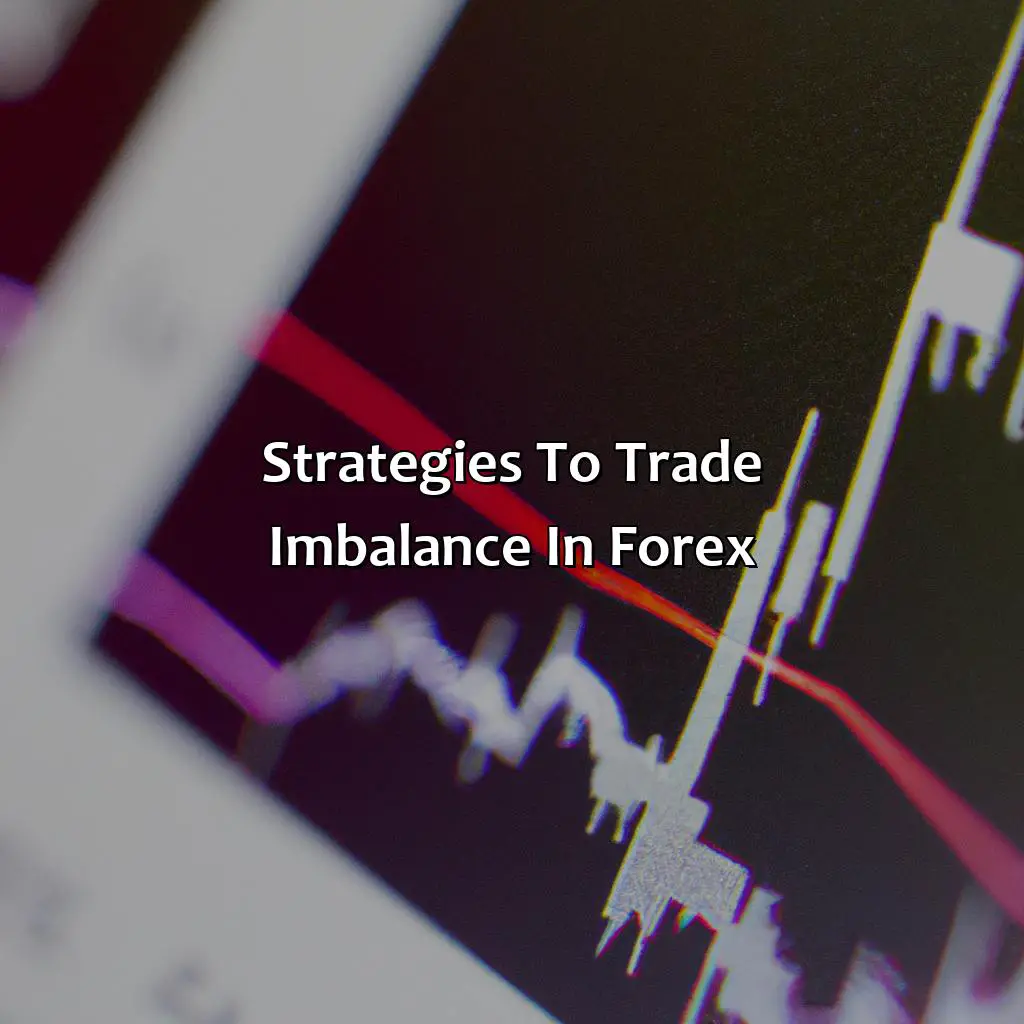
Photo Credits: forexbrokerreport.com by Eric Wright
Maximizing profits and minimizing losses while trading forex? Essential! Strategies are key. To succeed in forex trading, you must know effective trading strategies such as:
- Scalping
- News Trading
- Stop Hunting
- Order Flow Trading
- Trend Trading
Use these strategies to gain an edge in the forex market and attain your trading objectives.
Scalping
To execute scalping, traders may utilize indicators such as moving averages, Bollinger Bands or Stochastic Oscillators. In addition, they look for opportunities in pairs with tight spreads and high liquidity to lower the cost of trading.
Scalping is risky, as it requires quick decision-making and discipline. Losses can mount fast if the trader does not keep a close eye on their trades or apply proper risk management techniques like using stop-loss orders.
Although scalping is not suitable for all traders, it can be profitable when done correctly. It requires practice and experience to develop a personalized approach that works best for each trader’s style.
A professional trader reported making over $1000 per day consistently using scalping strategies on different currency pairs during two years of trading experience.
Who needs a crystal ball when you can trade the news and predict the unpredictable in the forex market?
News Trading
To trade successfully using news, traders need access to reliable sources of economic news as soon as it’s released. Professional traders use high-speed financial news feeds that send information within milliseconds of it being released. This allows them to respond quickly and stay ahead of other traders who may not have access to the same information.
To mitigate risk when trading economic news, traders often use stop-loss orders to limit potential losses if the market moves against their position. Additionally, because economic data can be subject to revision or correction later on, many traders choose to wait for confirmation before entering trades based on initial reports.
One prominent example of how economic news affects forex markets is seen in the release of the US Non-Farm Payroll (NFP) report every first Friday of the month at 8:30 am EST. This report is closely watched by traders worldwide as it provides key insights into the state of the U.S labor market and has been known to cause significant volatility in currency markets.
Stop hunting is like playing hide and seek with your stop loss, except the market always knows where you’re hiding.
Stop Hunting
In Forex trading, ‘Stop Hunting’ refers to a practice where traders set up trades with the intention of triggering stop-loss orders of other traders and causing price fluctuations. This tactic is usually employed by experienced traders to profit from novice traders who place stop-loss orders without considering the market conditions.
Stop hunting is a form of market manipulation that involves triggering predetermined limit or stop orders in order to create liquidity for one’s own trades. It is executed by selling short or buying long positions on large volumes to force prices down or up, respectively. Traders then buy back or sell out of these positions once the stops have been triggered, profiting from the subsequent price movements.
To avoid being caught in stop hunting, traders must consider the market environment and adjust their stop-loss orders accordingly. They should also closely monitor any sudden price movements that could indicate market manipulation.
One effective way to trade against stop hunting is through order flow trading, which involves tracking buying and selling activities of large institutions and using this information to make profitable trades. Another strategy is trend trading, where traders hold positions for an extended period based on longer-term price trends.
Keep calm and let order flow trading guide your forex journey towards success.
Order Flow Trading
Order flow trading is a strategy that analyzes the buying and selling activity of currency pairs in real-time. It seeks to identify where significant orders sit and how they are being filled, ultimately providing clues as to which direction the price may move. By closely monitoring market orders, limit orders, stop orders and other volume data, traders who use order flow trading look for imbalances in supply and demand which can indicate potential shifts in the market.
This type of trading utilizes techniques such as tape reading and cluster analysis to identify buying or selling pressure, managing stops, and even executing trades. It allows traders to spot trends before they become noticeable to others by scanning raw trade data for information about current market conditions.
Using order flow trading can be a profitable approach if done correctly. However, it requires specialized knowledge of market structure and supply/demand dynamics. Additionally, professional-grade tools such as depth of market (DOM) charts are necessary for executing this strategy effectively.
To successfully implement this approach, traders should adopt a rigorous discipline about order entry, risk management, and position sizing. It’s also essential to monitor factors like news releases that could impact global currencies’ pricing in real-time while utilizing techniques like scalping or trend trading strategies. By following these steps carefully, traders improve their chances of success with an innovative approach that leverages what traditional technical analysis tools cannot provide – access inside high-volume streaming financial markets.
“Riding the trend is like catching a wave, you just have to know when to jump on and when to bail.”
Trend Trading
Trend trading involves analyzing the market to identify sustained directional price movement and entering positions that follow the trend. This strategy aims to capture profits as long as the trend remains intact by using technical analysis tools such as moving averages, trend lines, and chart patterns.
In trading with trends, traders attempt to exploit temporary price movements by relying on pattern recognition and statistical analysis of historical data. By doing so, they attempt to take advantage of market inefficiencies in order to maximize their profits.
When trend trading, traders might look for strong trends in a particular currency pair across multiple time frames before entering a position. Setting stop-loss orders is one way to mitigate risk when trading with trends.
The history of trend trading dates back many decades when traders realized that markets have an inherent tendency to move in persistent directions for extended periods of time. In fact, some of the most legendary traders like Jesse Livermore were trend followers who believed in letting their winning trades run as long as possible.
Five Facts About How Imbalance Works in Forex:
- ✅ Imbalance occurs when there are more buyers or sellers in a particular currency pair, leading to a shift in price. (Source: Investopedia)
- ✅ Imbalance can be caused by a variety of factors, including economic news, geopolitical events, and market sentiment. (Source: FXCM)
- ✅ Traders can use tools like order flow and market profile to identify and capitalize on imbalances in the forex market. (Source: Forex Training Group)
- ✅ Imbalances can occur at various timeframes, from short-term intraday movements to longer-term trends. (Source: DailyFX)
- ✅ Proper risk management is crucial when trading imbalances in forex, as unexpected market events can lead to significant losses. (Source: Trading Psychology Edge)
FAQs about How Does Imbalance Work In Forex?
How does imbalance work in forex?
Imbalance in forex occurs when there is a shortage of buyers or sellers of a particular currency, causing the price to move in the opposite direction of the order flow. This could lead to high volatility and potential losses for traders.
What role do security and legislation play in forex trading?
Security and legislation are crucial aspects of forex trading. Proper regulation ensures that the market remains fair and transparent for all participants, while security measures protect traders’ funds and personal information from cyberattacks and fraud.
Can investing in shares and forex provide similar returns on investment?
While shares and forex can both offer returns on investment, the profit margins and risks differ significantly. Forex trading is generally considered more volatile and high-risk compared to investing in shares, which can lead to higher potential returns but also greater potential losses.
How do free markets impact forex trading?
Free markets play a significant role in forex trading, as they allow for open competition and efficient price discovery. A lack of government intervention also means that traders can take advantage of a currency’s true market value and make informed trading decisions based on supply and demand.

